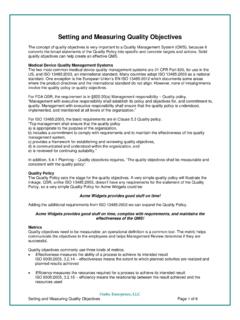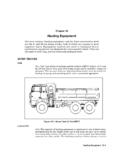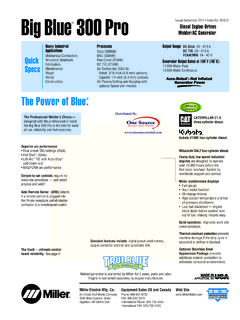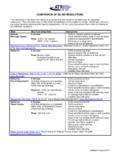Transcription of Equipment Utilization Metrics - Ombu Enterprises
1 Ombu Enterprises , LLC Equipment Utilization Metrics Page 1 of 4 Equipment Utilization Metrics A standard set of Metrics comes from the concept of Total Productive Maintenance (TPM). The book TPM Development Program1 is one of the many sources for this kind of analysis. This description follows that approach, but simplifies and clarifies some of the Metrics . Breakdown Loss Breakdowns cause two kinds of loss: time and quantity. Acute breakdowns (sudden, dramatic, and unexpected) are obvious and get attention. Chronic breakdowns are minor and are often ignored or neglected when attempts to cure them don t yield success. Setup and Adjustment Loss These losses result when the production Equipment is changed from one item (part number) to another.
2 The Equipment adjustment sets it up for the next part number. Idling and Minor Stoppage A minor stoppage is when the production stops for a temporary malfunction, or the Equipment is idling. For example, a piece might block a chute causing the Equipment to idle. Another case occurs when a sensor shuts down the Equipment when it detects a problem. Reduced Speed Loss This loss happens when a machine operates below the design speed. For example, a machine s design may call for 20 pieces per minute, but the machine actually operates at only 16 pieces per minute. Some reasons include mechanical problems, a history of past problems, or concerns of over exerting the Equipment .
3 Quality Defects and Rework These losses occur from quality defects and any associated rework. Acute quality problems are obvious and promptly corrected. Chronic problems may not be so obvious, and may not receive attention. Startup Loss This loss occurs during early stages of production from when the Equipment starts up until it stabilizes. In the TPM model, the following formula calculates Equipment effectiveness. Equipment effectiveness = Availability Performance rate Quality rate Availability improvement comes from eliminating breakdowns, set-up and adjustment losses, and other stoppage losses. Performance improvement comes from eliminating speed losses, minor stoppages, and idling.
4 Quality improvement comes from eliminating quality defects during startup or production. The calculations require some definitions. These definitions usually involve some period such as a shift, a day, a week, or a month. In addition, the units of measure have to be same in all of the calculations. In 1 TPM Development Program ed. Seiichi Nakajima. Productivity Press ISBN 0-915299-37-2. Chapter title Equipment Effectiveness, Chronic Losses, and Other TPM Improvement Concepts by Kunio Shirose. Ombu Enterprises , LLC Equipment Utilization Metrics Page 2 of 4 our example, we use minutes.
5 These definitions are simplified and clarified from those presented in the TPM book cited above. Figure 1 is a pictorial illustration of the times involved in the calculations. Operation Time is the total time available for operation during the period (shift, day, week, month, etc.) Loading Time is the time the Equipment is loaded and running, and is the operation time minus downtime. Downtime is time the Equipment is not available to produce parts and includes both planned downtime and unplanned downtime. Planned downtime is time the Equipment is not available to produce parts based on scheduled events such as set-up time, adjustment time, employee breaks, scheduled maintenance, and shop floor meetings.
6 Unplanned downtime is time the Equipment is not available to produce parts based on unscheduled events such as corrective maintenance, idling, and minor stoppages. Availability is the ratio of Loading time to Operation time and represents the percentage of time the Equipment is available to produce parts. Availability = Loading time / Operation time Speed loss time is the time lost because the Equipment is running below design speed. It is the actual time to make the production quantity minus the design time to make the same quantity. Speed loss time = Parts produced (Design cycle time Actual cycle time) Figure 1 Pictorial Illustration of Time Ombu Enterprises , LLC Equipment Utilization Metrics Page 3 of 4 Cycle time is the time to produce one part.
7 Design cycle time is the Equipment s designed production rate. Actual cycle time is the Equipment s actual production rate. Design operating time is the time the Equipment should have taken to produce the parts and is the difference between the loading time and the speed loss time. Note: The loading time is the actual time the Equipment produced parts. Performance rate is the ratio of the design operating time to loading time. Performance rate = Design operating time / Loading time Quality loss time is the time lost making nonconforming material. Quality loss time = Nonconforming parts Actual cycle time Valuable operating time is the time the Equipment spends making conforming material.
8 Quality rate is the ratio of conforming parts produced to total parts produced. A Worked Example Assume we are looking at one machine operating for one shift, and the machine requires attended operation, , it cannot run without an operator present. The total operation time for the shift is 8 hours 60 minutes/hour = 480 minutes The planned downtime for the shift is: 50 minutes Breaks: 2 15 minutes = 30 minutes Setup and adjustment: 20 minutes The unplanned downtime experienced that shift is: 20 minutes Unplanned breakdown and repair: 20 minutes The loading time is 480 50 20 = 410 minutes. The availability is 380/480 = or During the shift, the machine produced 760 units.
9 The actual cycle time is 380 minutes/760 units or minutes per unit. The design cycle time is minutes/unit. The speed loss time is 760 ( ) = 760 = 76 minutes. The performance rate is (380 76)/380 = 304/380 = or The Equipment produced 19 nonconforming pieces during the shift for a nonconformance rate of approximately ( ). The quality rate is (760 19)/760 = 741/760 = or Ombu Enterprises , LLC Equipment Utilization Metrics Page 4 of 4 The total Equipment effectiveness for the shift is the product of the availability, the performance rate, and the quality rate. = or For the shift, the Equipment achieves about of the operation time.
10















